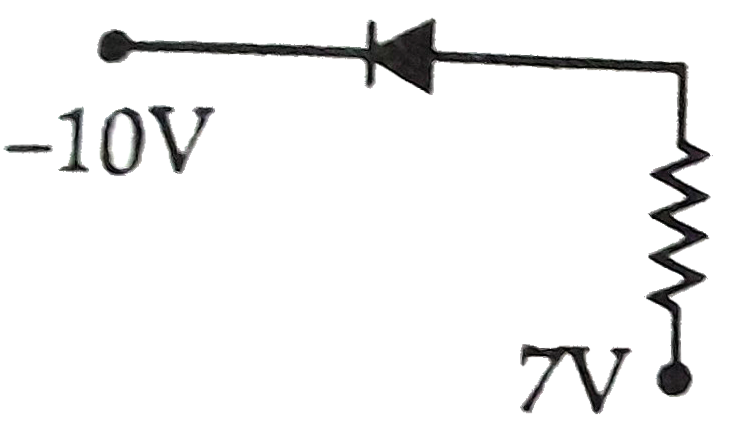In which of the following figure the junction diode is reverse biased ?




The correct Answer is:B
To determine which of the given figures shows a reverse-biased junction diode, we need to analyze the conditions for forward biasing and reverse biasing of a PN junction diode.
1. Understanding Forward and Reverse Bias:
- A PN junction diode is forward biased when the P-side (anode) is connected to a higher potential than the N-side (cathode). This allows current to flow through the diode.
- A diode is reverse biased when the P-side is connected to a lower potential than the N-side, preventing current from flowing.
2. Analyzing Each Option:
- Option A:
- P-side voltage = 7V
- N-side voltage = -10V
- Since 7V (P-side) > -10V (N-side), this diode is forward biased.
- Option B:
- P-side voltage = -10V
- N-side voltage = 0V (earthing)
- Since -10V (P-side) < 0V (N-side), this diode is reverse biased.
- Option C:
- P-side voltage = 0V (earthing)
- N-side voltage = -10V
- Since 0V (P-side) > -10V (N-side), this diode is forward biased.
- Option D:
- P-side voltage = -10V
- N-side voltage = 7V
- Since -10V (P-side) < 7V (N-side), this diode is reverse biased.
3. Conclusion:
- From the analysis, we find that:
- Option B and Option D are reverse biased.
- Therefore, the correct answer is B and D.
- A PN junction diode is forward biased when the P-side (anode) is connected to a higher potential than the N-side (cathode). This allows current to flow through the diode.
- A diode is reverse biased when the P-side is connected to a lower potential than the N-side, preventing current from flowing.
- Option A:
- P-side voltage = 7V
- N-side voltage = -10V
- Since 7V (P-side) > -10V (N-side), this diode is forward biased.
- Option B:
- P-side voltage = -10V
- N-side voltage = 0V (earthing)
- Since -10V (P-side) < 0V (N-side), this diode is reverse biased.
- Option C:
- P-side voltage = 0V (earthing)
- N-side voltage = -10V
- Since 0V (P-side) > -10V (N-side), this diode is forward biased.
- Option D:
- P-side voltage = -10V
- N-side voltage = 7V
- Since -10V (P-side) < 7V (N-side), this diode is reverse biased.
- From the analysis, we find that:
- Option B and Option D are reverse biased.
- Therefore, the correct answer is B and D.
Topper's Solved these Questions
Similar Questions
Knowledge Check
In which of the following figures, junction diode is forward biased?
A B
B C
C D
D
A p−n junction diode is reverse biased. Then
Amore current flowsBthe barrier potential decreasesCthe barrier potential increasesDresistance offered is lowWhen a p-n junction diode is reverse biased
Aelectrons and holes are attracted towards each other and move towards the depletion region.Belectrons and holes move away form the deplection region.Cheight of the potential barrier decreasesDno change in the current takes place
Which one of the following semiconductor diodes is reverse biased?

View SolutionWhich of the following semi-conductor diodes is reverse biased
View SolutionWhich of the following semiconductor diodes is reverse biased?
View SolutionIn the following, which one of the diodes is reverse biased –
View SolutionOf the diodes shown in the following figures, which one is reverse biased ?
View Solution
